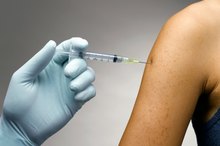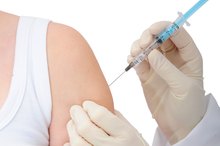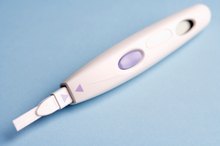Symptoms of Pregnancy If HCG Injection Is Taken
If you're undergoing fertility treatment to get pregnant, you might take human chorionic gonadotropin, better known as hCG. This hormone stimulates the release of an egg -- or eggs -- from the ovary. Because hCG is the same hormone produced by the growing placenta in early pregnancy, hCG given by injection will give a positive result on a pregnancy test as long as it stays in your system. Both hCG and another commonly given fertility drug, progesterone, can cause symptoms similar to those of early pregnancy.
Uses of hCG
When you take fertility drugs during an in vitro fertilization, or IVF, cycle, it's important to control the timing of ovulation. The eggs are removed from the follicles that develop in the ovary with a fine needle during egg retrieval. When follicles get too large, they might ovulate before the egg retrieval, which prevents the IVF team from fertilizing them in the laboratory and placing them into the uterus several days later. To prevent early egg release, your doctor instructs you to take hCG between 34 and 35 hours before an egg retrieval, since ovulation generally does not occur until 36 hours after the injection. The hCG also matures the eggs so they'll be ready for fertilization after retrieval.
- When you take fertility drugs during an in vitro fertilization, or IVF, cycle, it's important to control the timing of ovulation.
- When follicles get too large, they might ovulate before the egg retrieval, which prevents the IVF team from fertilizing them in the laboratory and placing them into the uterus several days later.
Symptoms With hCG
How Long After Conception Can You Tell If You Are Pregnant?
Learn More
Injection of hCG can cause fluid retention, irritability, depression and headache. Because these same symptoms can occur in early pregnancy, you might feel like you're pregnant even if you are not. Because women undergoing fertility treatment often take progesterone -- which has many of the same side effects -- after the embryo transfer, such symptoms are not a good indicator of potential pregnancy.
Staying Power of hCG
A single injection of hCG stays in your system for approximately 7 days, according to the medical text "Contemporary Perspectives on Assisted Reproductive Technology." If you do an over-the-counter urine test or blood test before that time, it will show a false-positive result, since the test detects the hCG left over from the injection. If you only had a single injection to induce ovulation, the hCG will be gone by the time you do your first pregnancy test, between 10 to 12 days after the injection. However, some fertility specialists give serial doses of hCG every few days to support a growing pregnancy after the embryo transfer. If you take hCG in the luteal phase -- the time between the embryo transfer and your next menses -- your pregnancy test will be positive even if you are not pregnant.
- A single injection of hCG stays in your system for approximately 7 days, according to the medical text "Contemporary Perspectives on Assisted Reproductive Technology."
- If you only had a single injection to induce ovulation, the hCG will be gone by the time you do your first pregnancy test, between 10 to 12 days after the injection.
Determining Whether You're Pregnant
Common Side Effects of the HCG Trigger Shot
Learn More
To determine whether you are pregnant when taking serial injections of hCG, your doctor will order blood tests every few days. Unlike urine pregnancy tests, blood tests measure the precise amount of hCG in the blood. Urine pregnancy tests give only a qualitative result -- positive or negative. By doing a series of blood tests, your doctor can evaluate whether your hCG level is rising, as it normally does in the first few weeks of pregnancy. If your hCG level does not rise, you probably are not pregnant. An early ultrasound in the fourth to fifth week of pregnancy can give you a definite answer.
- To determine whether you are pregnant when taking serial injections of hCG, your doctor will order blood tests every few days.
Related Articles
References
- Contemporary Perspectives on Assisted Reproductive Technology; 2006
- Practical Gynecology; Janice Ryden, M.D. and Paul D. Blumenthal, M.D., eds.
- The Art and Science of Assisted Reproductive Techniques; Gautam N. Allahbadia, et al., eds.
- Daily Med: Novarel
- Kamalanathan S, Sahoo JP, Sathyapalan T. Pregnancy in polycystic ovary syndrome. Indian J Endocrinol Metab. 2013;17(1):37–43. doi:10.4103/2230-8210.107830
- Legro RS. Evaluation and Treatment of Polycystic Ovary Syndrome. In: Feingold KR, Anawalt B, Boyce A, et al., editors. Endotext [Internet]. South Dartmouth (MA): MDText.com, Inc. Updated January 11, 2017.
- Chard T. Pregnancy tests: a review. Hum Reprod. 1992;7(5):701-10. doi:10.1093/oxfordjournals.humrep.a137722
- Foxcroft KF, Callaway LK, Byrne NM, Webster J. Development and validation of a pregnancy symptoms inventory. BMC Pregnancy Childbirth. 2013;13:3. doi:10.1186/1471-2393-13-3
- Rostami Dovom M, Ramezani Tehrani F, Djalalinia S, et al. Menstrual Cycle Irregularity and Metabolic Disorders: A Population-Based Prospective Study. PLoS One. 2016;11(12):e0168402. doi:10.1371/journal.pone.0168402
- Moran LJ, Harrison CL, Hutchison SK. Exercise decreases anti-müllerian hormone in anovulatory overweight women with polycystic ovary syndrome: a pilot study. Horm Metab Res. 2011;43(13):977-9.
- Palomba S, De wilde MA, Falbo A, Koster MP, La sala GB, Fauser BC. Pregnancy complications in women with polycystic ovary syndrome. Hum Reprod Update. 2015;21(5):575-92. doi:10.1093/humupd/dmv029
- Moran LJ, Harrison CL, Hutchison SK. Exercise decreases anti-müllerian hormone in anovulatory overweight women with polycystic ovary syndrome: a pilot study. Horm Metab Res. 2011 Dec;43(13):977-9.
Writer Bio
A registered nurse with more than 25 years of experience in oncology, labor/delivery, neonatal intensive care, infertility and ophthalmology, Sharon Perkins has also coauthored and edited numerous health books for the Wiley "Dummies" series. Perkins also has extensive experience working in home health with medically fragile pediatric patients.









